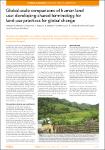Global-scale comparisons of human land use: developing shared terminology for land-use practices of significance for global change.
| dc.contributor.author | Morrison, KD | |
| dc.contributor.author | Hammer, E | |
| dc.contributor.author | Popova, L | |
| dc.contributor.author | Madella, M | |
| dc.contributor.author | Whitehouse, NJ | |
| dc.contributor.author | Gaillard, M-J | |
| dc.date.accessioned | 2023-10-11T10:25:17Z | |
| dc.date.available | 2023-10-11T10:25:17Z | |
| dc.date.issued | 2018-06-01 | |
| dc.identifier.issn | 2411-605X | |
| dc.identifier.issn | 2411-9180 | |
| dc.identifier.uri | https://pearl.plymouth.ac.uk/handle/10026.1/21365 | |
| dc.description.abstract |
Although archaeological data are needed to understand the impacts of past human land use on the Earth system, synthesis is hampered by a lack of consistent categories. We develop hierarchical and scalable land-use classifications for use across the globe. Human land-use practices have been highly variable over the course of the Holocene, a diversity evident in the differentiated effects of human activity on land cover. Historically, agriculture was one of the most significant forms of land use, but even mobile hunter-gatherers transformed land cover through landscape-scale burning (Bliege Bird 2008). Livestock-keeping, plowing, irrigation, and the production of metal, ceramics, and bricks, have also been drivers of historical change. It is important to understand the aggregate effects of anthropic activities on the Earth system, but significant challenges are posed by: (1) the complexity, diversity and mosaic nature of human land use itself (Fig. 1); (2) the need to develop a uniform vocabulary and terminology for land-use practices around the globe and across the span of human history; (3) the sheer quantity of evidence to be analyzed; and (4) the lack of a tradition of global-scale comparisons. Nevertheless, there is a deep reservoir of expertise about land-use and land-cover transitions waiting to be tapped. One goal of LandCover6k is to improve understanding of the relationships between land-use and land-cover changes (Gaillard et al., this issue). By comparing land-use and land-cover trends, we can better disentangle anthropogenic forms of land- cover change from climatic or other drivers. | |
| dc.format.extent | 8-9 | |
| dc.publisher | Past Global Changes (PAGES) | |
| dc.subject | 31 Biological Sciences | |
| dc.subject | 3103 Ecology | |
| dc.subject | 15 Life on Land | |
| dc.title | Global-scale comparisons of human land use: developing shared terminology for land-use practices of significance for global change. | |
| dc.type | journal-article | |
| plymouth.issue | 1 | |
| plymouth.volume | 26 | |
| plymouth.publisher-url | http://www.pastglobalchanges.org/products/latest/12461-global-scale-comparisons-of-human-land-use-developing-shared-terminology-for-land-use-practices-for-global-change | |
| plymouth.publication-status | Published | |
| plymouth.journal | Past Global Changes | |
| dc.identifier.doi | 10.22498/pages.26.1.8 | |
| plymouth.organisational-group | |Plymouth | |
| plymouth.organisational-group | |Plymouth|Faculty of Science and Engineering | |
| plymouth.organisational-group | |Plymouth|REF 2021 Researchers by UoA | |
| plymouth.organisational-group | |Plymouth|REF 2021 Researchers by UoA|UoA14 Geography and Environmental Studies | |
| dcterms.dateAccepted | 2018-06-01 | |
| dc.date.updated | 2023-10-11T10:25:16Z | |
| dc.rights.embargodate | 2023-10-17 | |
| dc.identifier.eissn | 2411-9180 | |
| rioxxterms.versionofrecord | 10.22498/pages.26.1.8 |


